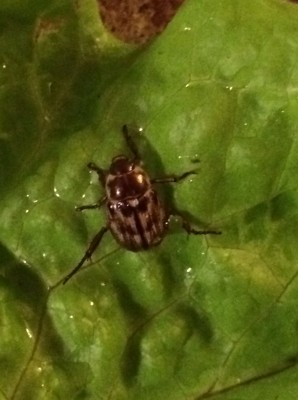Photo and article by Joan Allen

Last week, an adult Oriental beetle was spotted on some lettuce in our vegetable garden. This in itself is not really a big deal because, unlike Japanese and Asiatic garden beetles, these adults are not voracious feeders and don’t typically require control. It can be important for a couple of other reasons though, to note the annual emergence of this species. One is that it typically precedes the emergence of the Japanese beetle by 1-2 weeks, so it’s a heads-up to be on the lookout for them. The other is that the larvae or grub stage of the Oriental beetle can cause significant damage to the roots of cool season turfgrasses and some ornamental plants including those in pots.
The adults are 3/8 to 7/16” long and have quite variable color and markings. They can range from light tan to dark brown and many have alternating dark and light line patterns on the wing covers (elytra). After emerging in mid to late June in southern New England, beetles feed and mate. Females lay eggs a few inches deep in moist soil in small groups for a total of 20-30 eggs per individual. If drought conditions prevail, egg-laying may be delayed as long as into September. Grubs hatch 18-24 days later under average temperature and weather conditions and feed on roots and organic matter near the soil surface. As grubs increase in size and grow through three instars or stages, the amount of damage done to host plants increases too. Third instar larvae overwinter deep in the soil (8-17”). They migrate upward and resume feeding when the soil warms in the spring. After feeding for 4-5 weeks, the grubs pupate and transform into adults, completing the annual life cycle.
If you are concerned (or know) that white grubs, the larvae of Oriental, Japanese and several other scarab beetles, are damaging your lawn or other plants, it is important to correctly identify the beetle species for selection of the most effective control strategies. Pheromone traps are available to monitor for the presence of adult male Oriental beetles. Because these traps only attract males, they do not have the potential to increase damage in the area as Japanese beetle traps can. Identification of white grubs to species requires a close look at their little rumps. Using a hand lens, inspect the pattern of ‘hairs’ on the lower side. The Oriental beetle grub has two parallel rows of small hairs down the middle.
How do you know if you have enough grubs to warrant a control product? For Oriental beetle, thresholds of 8-10 grubs per square foot of lawn are suggested. Peel back a one-foot square section of turf and check the soil and roots for grubs. White grubs will be in a C shape. They’re going to be most numerous and problematic in sunny areas. Don’t forget about grub identification!
Management strategies include cultural practices, biocontrols and chemical insecticides. For both biocontrol and most chemical products, the early instar or youngest grubs are the most vulnerable and therefore the most easily controlled. More information on these can be found at these links:
http://www.beyondpesticides.org/alternatives/factsheets/Grubs.pdf
http://www.ct.gov/caes/cwp/view.asp?a=2815&q=376940
Connecticut claim to fame: The Oriental beetle was first confirmed in the United States here in 1920. It didn’t appear to spread much until around the 1970s. Since then it has expanded its U.S. distribution to include most of the east coast and extending westward to Ohio.
If you need assistance with grub or beetle identification, or control tips, contact the UConn Home & Garden Education Center by phone at 860-486-6271 or by email at ladybug@uconn.edu.